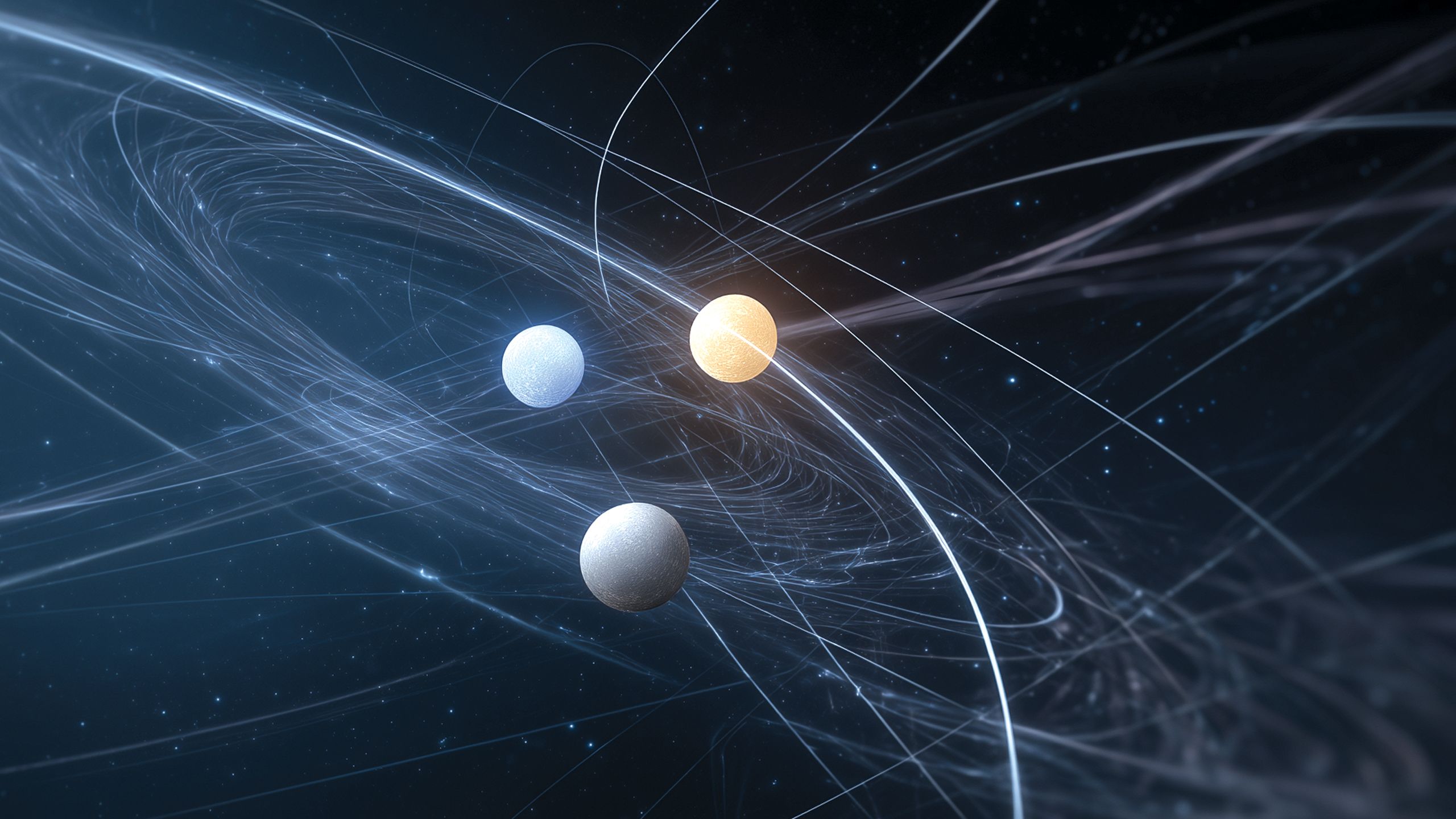The Three-Body Problem

In This Article
-
The three-body problem produces chaotic orbits, with trajectories that collapse into unpredictability.
-
Even the tiniest change produces dramatically different results.
-
What appears to us as silence may actually be a vast, dark forest filled with civilizations hiding in fea
The science fiction novel The Three-Body Problem by Liu Cixin is the story of an interstellar communication initiated by Chinese scientists in 1976. In this fictional story, we are introduced to a highly secretive military initiative known as the Red Shore Project. Using a massive radio telescope built for this purpose, they transmitted a signal to the Trisolaris system, about 4.21 light-years from Earth. At that distance, the message would take four years to arrive, and if anyone there were able to respond, their reply would reach Earth four years later.
Four years after the transmission, Chinese scientists listened to the silence of space, hearing nothing but static. Then, one day, the unexpected happened: a voice broke through the emptiness, crossing the vast distance to reach Earth. The scientists, riveted, turned their attention to the mysterious signal. Humanity was on the brink of perhaps its greatest discovery.
As the message was decoded, anticipation gave way to dread. The first words from extraterrestrial beings were not a greeting but a chilling warning: “Do not send another message ever again. Otherwise, it will be your end.”
The Three-Body Problem is a science fiction novel by Liu Cixin that gained worldwide attention through its television adaptation. In the story, Trisolaris is a planet in the Alpha Centauri star system, about 4.21 light-years from Earth. The planet orbits within a chaotic three-star system, where unpredictable gravitational forces cause instability. As a result, Trisolaris experiences irregular cycles: periods of extreme heat and cold known as Chaotic Eras, alternating with Stable Eras, when conditions are more favorable for life.
The fictional story in Liu Cixin’s novel is intertwined with real science: the Three-Body Problem. This is a well-known challenge in physics and mathematics that dates back to Isaac Newton’s Principia Mathematica (1687). In Proposition 66 of the first book, Newton described the motion of three large bodies under mutual gravitational forces. While studying the orbits of planets in the Solar System, he realized he needed mathematical equations to express the problem. When he assumed only two bodies, he was able to write and solve the equations. But when he considered three bodies, the problem became unsolvable.
Many mathematicians took up this challenge, but the problem remained unsolved for centuries. Writing the differential equations for three bodies was straightforward, but finding an analytical solution was impossible. Unlike the two-body problem, the three-body problem produces chaotic orbits, with trajectories that collapse into unpredictability. Finally, the great mathematician Henri Poincaré proved that no general analytical solution exists for such systems. This realization laid the foundation of chaos theory.
Chaotic systems, by their nature, cannot be expressed with simple functions like polynomials, trigonometric or logarithmic formulas. Their defining feature is extreme sensitivity to initial conditions: even the tiniest change produces dramatically different results. Later studies on chaos theory confirmed that this unpredictability is not due to lack of knowledge or inadequate calculation but is an inherent property of such systems. Many examples of chaotic behavior have since been discovered—Lorenz attractors, fractals, triple pendulums, even a pencil balanced on its tip.
The best way to understand this situation is through simulations. By modeling three bodies at different distances with only a few parameters, one can observe how quickly the results spiral into chaos. Even the Solar System is much more complex than previously thought. In 2009, shortly after Liu Cixin’s novel gained attention, astrophysicists ran a large-scale simulation using all known data about the Solar System to predict planetary positions 5 billion years into the future. Then they adjusted Mercury’s distance from the Sun by just 1 millimeter. That tiny difference produced radically different outcomes: in some simulations Mercury collided with the Sun, in others with Venus, and in at least one case the entire Solar System fell into chaos.
Yes, you read that right. A deviation of only 1 millimeter could alter the destiny of the cosmos. Such precision suggests that every object in the universe must be perfectly placed for order to be sustained. Otherwise, disorder would prevail. This brings to mind the Qur’anic verse: “God has created everything with precise measure” (54:49), and the call: “Travel throughout the earth and see how He brings life into being” (29:20).
The message from extraterrestrial beings mentioned at the beginning of the article sparks another discussion. It recalls Stephen Hawking’s warning to be cautious in the search for alien life, lest humanity expose itself to danger. While we may send messages of friendship, we could be inviting beings with superior technology to view us as prey. This idea is central to The Three-Body Problem series.
Let's start with the Fermi Paradox. Enrico Fermi, a real scientist, once posed a question: There are billions of stars in the Milky Way. Most of these stars should have planets orbiting around them. Some of these planets must have the capacity to develop and sustain life, just like ours. Some forms of life should have the ability to evolve into civilizations and at least have the capability to discover radio waves, even if they don't have space travel. Fermi later suggests this: If all of these previous points are true, then where are the aliens? This is what we call the Fermi Paradox.
The Dark Forest Hypothesis, also the title of the second book in the series, offers a theoretical solution to the Fermi Paradox. At the very least, advanced civilizations should have discovered radio waves. According to this hypothesis, the reason we have not detected signals or received visits is rooted in the instinct for survival. Making contact with an unknown species is inherently risky—any civilization that reveals itself may face extinction, since there is no way to predict the intentions of the other side. From this perspective, it becomes more rational to destroy any encountered species rather than risk being destroyed. This is what Stephen Hawking warned about when he cautioned against broadcasting our presence too openly.
Just as we are often bothered by insects and think little of killing them, they might view us the same way. If different species at varying levels of development exist across the universe, it would take only one or two to adopt this perspective: destroy others on sight rather than risk contact. Once that happens, the rest quickly learn the lesson—remaining silent is the only way to survive.
According to the Dark Forest Hypothesis, this survival logic drives the universe toward a kind of uneasy equilibrium. What appears to us as silence may actually be a vast, dark forest filled with civilizations hiding in fear, each wary and hostile beneath the surface. Any civilization that dares to reveal itself risks instant destruction by others unwilling to endanger their own existence. As we contemplate the intricacies of the cosmos, "The Three-Body Problem" and the scientific theories it incorporates offer a sobering reflection on the fragility and unpredictability inherent in even the most meticulously ordered systems. Just as the slightest deviation in initial conditions can yield chaotic outcomes, our presence on Earth exists in a delicate equilibrium, vulnerable to the unseen forces of the universe.
Rather than serving as a mere warning, the message from extraterrestrial beings may serve as an invitation for us to approach the unknown with humility, caution, and a profound reverence for the complexities of God's creation. Through observation and reflection upon the signs present in our surroundings, we have the opportunity not only to unravel the mysteries of the universe but also to deepen our understanding of our role within it and the profound responsibility entrusted to us as stewards of this remarkable and awe-inspiring world.









